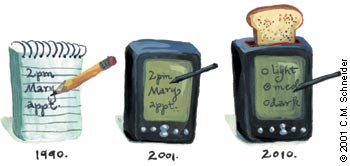
Thinking about joining the hand-held revolution? Here are five points to consider before you buy.
Fam Pract Manag. 2001;8(7):50-51

Personal digital assistant (PDA) is actually a catchall term for the plethora of battery-operated, hand-held electronic devices on the market today. While a PDA cannot replace a standard-sized computer, it often serves as an extension to one because of its small size, portability and ease of use. PDAs are great for keeping daily schedules, taking notes and looking up and recording clinical information. Unfortunately, they don’t currently have the capacity to hold electronic medical records (EMRs) or to store large graphics. Nor do they have a great deal of interactive capability. Still, they are excellent devices for managing clinical information and accessing it at the point of care.
If you’re considering purchasing a PDA, consider these five important points before you buy:
Functionality. Some physicians use their PDAs solely as personal organizers to keep their schedules, address books and to-do lists. Others use them for quick pharmacology references, for medical calculations and for taking brief notes during meetings and patient encounters. Still others use them for accessing more extensive clinical references (e.g., Harrison’s Principles of Internal Medicine and Griffith’s 5-Minute Clinical Consult [available at www.handheldmed.com]) and for record keeping. Before you purchase your first PDA, you should have a general idea of how you plan to use it in your daily practice. If you want to use it only as a replacement for your paper planner, consider purchasing a very basic PDA. However, if you plan to use it for clinical reference as well, you’ll want to choose one with more memory (discussed further below).
Operating system. While there are many brands of PDAs, most run on one of two operating systems: Palm OS or Windows CE. The difference between the Palm OS and Windows CE platforms is similar to the difference between Windows and Macintosh on personal computers. The two do not interface at all, nor can you interchange software written for them. PDAs manufactured by Palm and Handspring, among others, use the Palm OS, whereas Microsoft’s Pocket PC and Handheld PC use the Windows CE platform.
To determine which operating system is right for you, consider these factors:
The type of platform your colleagues are using (so that you can exchange information easily),
The type of platform your health care system prefers (so that your operating system will be compatible with any EMR or electronic prescribing applications the health care system implements),
Your personal preference. Windows CE looks similar to and interfaces well with Windows and other Microsoft products, such as Microsoft Word, on your personal computer. This familiarity can be comforting as you learn to use a PDA. More shareware (i.e., applications available for a nominal fee) has been written for the Palm OS, but most commercial medical software is available for operating systems.
Connectivity. A PDA used for more than organizational purposes is not a stand-alone device. It will need to be connected (via the cradle that comes with it) to your personal computer for regular backups, for loading and updating software, and for transferring information. If you want to print from your PDA, you will also need a special printer with an infrared port, which is similar in cost and availability to regular inkjet printers on the market.
Features. Basic PDA models come with 8 MB of memory, which is plenty for physicians who use PDAs mainly as electronic organizers. Most have built-in expansion slots so you can add memory, which you’ll probably need if you download some of the more memory-intensive clinical references like the Merck Manual (which requires 4 MB of memory). You’ll also need additional memory if you want to add some peripheral equipment, such as voice recorders, cellular phones or digital cameras. While the technology for these peripherals – as well as for direct Internet connectivity – is exciting, it’s still in development. A few PDA manufacturers currently offer direct internet connection (via modem and wireless radio frequency), but all the kinks haven’t been worked out and crashes occur often.
You should also consider whether you want a PDA with a color screen. While color certainly livens things up and makes reading easier, the graphic capabilities of PDAs are not advanced enough to make color worth the added expense at this time.
Another important decision is whether to buy a PDA with replaceable batteries or a rechargeable battery. Most models require two standard AAA batteries. With regular use, these will generally last two to three weeks. The downside is that when the batteries start to run down they tend to do so quickly and may require an immediate change, necessitating that you keep a ready supply of batteries on hand. Newer to the market are PDAs with batteries that recharge every time they are plugged into the PDA’s cradle.
Unless you travel a lot and need to find access to electrical outlets in unfamiliar places, rechargeable batteries are generally more convenient.
Shelf life. The current shelf life of most computer technology is approximately three years, and PDAs are no different. Like other technology, PDAs will improve rapidly in terms of memory, data storage, graphic capability and wireless interactivity in the near future. So as you shop for your first PDA, remember it probably won’t be the last one you buy. Most PDAs, even the ones with all the bells and whistles, will be obsolete in a few years. Our advice to physicians? Think about how you want to use a PDA right now, and buy accordingly. In six months, you may find it hard to recall how you ever practiced without one!